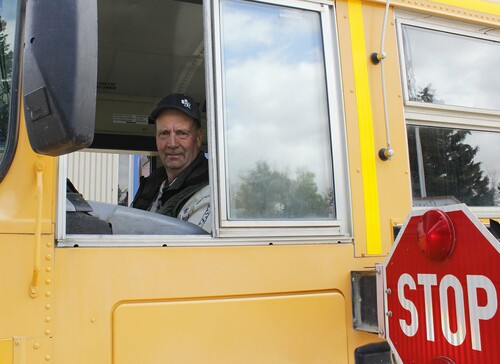
Don’t try to tell Arvid Thompson that school bus evacuations drills are about as useful as map-reading skills these days.
Lost travellers are more likely to look up Google Maps and the like, but the veteran driver with Palliser Regional Schools knows first-hand just how crucial bus safety exercises are.
In a 20-year span of driving school bus, Thompson never had occasion to put required safety drills into play. That all changed in a split second one day last October while taking students home after school in Vulcan.
Although he always made sure his students knew what to do in the event of a bus crash, Thompson admits he never imagined he’d be at the wheel in just such a situation. His bus was clipped by a vehicle attempting to pass it on a slippery stretch of highway near Milo, sending it into the ditch.
“Technically that should never have happened,” says Thompson, who was driving to the road conditions. “We can do everything perfectly correct, but there’s getting to be more careless drivers on the road every year. You have to drive for yourself and drive for the other person and, hopefully, you’re lucky and nobody does what they did to us.”
With the reality of that crash in mind, Palliser Regional Schools is stepping up its mock bus evacuations this school year to ensure everyone knows the proper procedures and realizes the importance of such exercises.
Thompson says he was aware of a vehicle pulling up behind the bus and saw it start to pass, but he was looking at the road ahead when metal hit metal.
“Whenever it happened, it happened so terribly fast that you didn’t really have an opportunity to do much of anything,” he says.
Thompson’s best efforts weren’t enough to keep the bus and its cargo of eight students from hitting the ditch backwards before rolling over one and a quarter times. Those past mock bus evacuations, however, appear to have paid off.
“Nobody really got panicky,” he says, adding older students led the younger ones out through the back exit since the bus was resting on its passenger side.
A student complaining of neck pain remained inside until medical help arrived. Fortunately bumps, scrapes and bruises proved the worst of the injuries.
“It went better than what you could have ever dreamed it would,” says Thompson. “We were extremely lucky no one was seriously hurt.”
Dave Shaw, Palliser’s Transportation Services Supervisor, says the question is whether passengers and drivers on all 59 bus routes are as well prepared.
“It just seemed like an opportunity to drive the point home,” he says. “We’ve got that fresh incident in our mind as a collective, and we can stress the importance not only to our drivers, but to the students, that stuff happens and we have to be ready. So let’s make sure that we’re taking this seriously.”
By law, school divisions must hold mock bus evacuations twice a year. The usual procedure is to bring two or three buses to a particular school, provide students with a safety talk and then have them all filter through the vehicles to practice exiting under different scenarios.
This year will feature specific evacuation days at each school, with all the buses and bus drivers that serve it involved in the exercise. All the students, whether they are regular riders or only take the bus for field trips or sporting events, will be involved.
Shaw will be there each time to provide feedback and follow up with extra training – for passengers or drivers – as required. While he’s quick to praise Thompson and his students for their actions that day, he knows everyone involved got away lucky.
“This is reality. It happened. It’s not meant to scare anybody, but it’s meant to make sure they understand that this could happen at any time,” he says.

